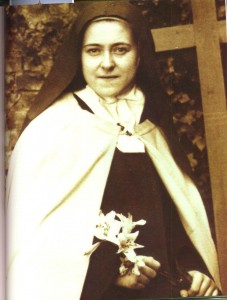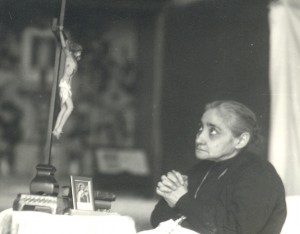St. Theresa of the Child Jesus
Her Parents
|
||
| Blessed Louis and Zelie Martin were beatified on October 19, 2008. Pope Francis is expected to canonize Blessed Louis and Zelie Martin, the parents of St. Therese of Lisieux, during the world Synod of Bishops on the family in October, 2015.
|
||
Her Early Years |
||
| Marie-Francoise-Therese Martin was born on January 2, 1873, and baptized two days later on January 4th. “All my life, God surrounded me with love. My first memories are imprinted with the most tender smiles and caresses…Those were the sunny years of my childhood.” Thus Therese, twenty-one years later, described her home life in Alencon, France. “My happy disposition,” she added with characteristic candor, “contributed to making my life pleasing.” | ||
Her School YearsIn October, 1881, Louis enrolled his youngest daughter (Therese) as a day boarder at Lisieux’s Benedictine Abbey school of Notre-Dame du Pre. Therese hated the place and stated “the five years (1881 – 1886) I spent there were the saddest of my life.” She worked hard, and loved catechism, history and science, but had trouble with spelling and mathematics. Her keenness aroused the envy of many fellow pupils, and Therese paid dearly for her academic successes. |
||
Life at Lisieux CarmelMarie Martin, the oldest daughter of the family, joined her sister Pauline at the Lisieux Carmel in 1886. Leonie Martin entered the Visitation Convent at Caen the following year. Therese then sought permission from her father to join Marie and Pauline at the Lisieux Convent. Three of his girls had already entered religious life, but Louis, characteristically generous, not only granted Therese’s request, but worked zealously to help her realize it. |
||
important dates
|
In the above picture of Luisa “The Little Daughter of the Divine Will” in prayer in front of the crucifix is a picture of St. Therese “The Little Flower”
Book of Heaven
From the writings of the Servant of God, Luisa Piccarreta
VOLUME 10
November 29, 1910 (Luisa Piccarreta) –
“While I was saying this, my blessed Jesus made Himself seen looking in my interior, turning everything upside down to
see if there was something which He did not like. And while turning and turning, He took something like a grain of
white sand in His hands, and He threw it to the ground. Then He said to me: “Dearest daughter of Mine, it is absolutely
right that for one who is all for Me, I be all for her. I am too jealous that someone else might give her the slightest
comfort. I alone – I Myself alone want to make up for all, and in everything. What is it that afflicts you? What do you
want? I do everything to make you content. Do you see that white grain that I removed from you? It was nothing but a
little bit of anxiety, for you wanted to know my Will from others. I removed it from you and I threw it on the ground so
as to leave you in holy indifference – the way I want you.”
This is very similar to what the “Little Flower”, wrote in her journal called “Story of a Soul” where she writes:
“Unfortunately when I have compared myself with the saints, I have always found that there is the same difference
between the saints and me as there is between a mountain whose summit is lost in the clouds and a humble grain of sand
trodden underfoot by passers-by. Instead of being discouraged, I told myself: God would not make me wish for
something impossible and so, in spite of my littleness, I can aim at being a saint. It is impossible for me to grow bigger, so
I put up with myself as I am, with all my countless faults. But I will look for some means of going to heaven by a little
way which is very short and very straight, a little way that is quite new.
The message given to Luisa was on November 29, 1910. St. Therese died 13 years earlier in 1897 and afterwards her
Sisters sent 2,000 copies of Therese’s writings to other convents. By 1910 St. Therese’s writings would be well know by
the Religious in Luisa’s hometown.
It was also in 1910, while visiting the Trani Diocese to establish an orphanage, Father Hannibal Di Francia met Luisa
Piccarreta for the first time, most likely at the suggestion of her confessor, Fr. Gennaro Di Gennaro. Soon thereafter,
Father Hannibal found himself at the center of a loose association of priests who shared a common thirst for holiness and
a deep admiration for Luisa. Members of the group included Father Gennaro Braccale, S.J.; Father Eustacchio
Montemuro, founder of the Sisters of the Divine Side; and Father Ferdinando Cento, who later became a cardinal.


